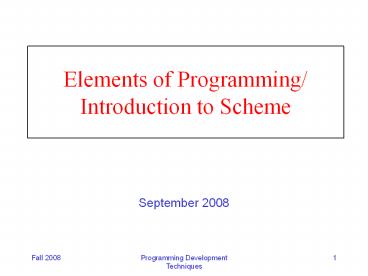Elements of Programming/ Introduction to Scheme - PowerPoint PPT Presentation
Title:
Elements of Programming/ Introduction to Scheme
Description:
Course Information. Instructor: Prof. Kathy McCoy (mccoy_at_cis.udel. ... Abstraction (treat combination like a primitive) In Scheme. Numbers, symbols. Lists, e.g. ... – PowerPoint PPT presentation
Number of Views:26
Avg rating:3.0/5.0
Title: Elements of Programming/ Introduction to Scheme
1
Elements of Programming/ Introduction to Scheme
- September 2008
2
Course Information
- Instructor Prof. Kathy McCoy (mccoy_at_cis.udel.edu
) - Place 209 Smith
Home page
http//www.cis.udel.edu/mccoy/courses/cisc280-08f
Course Syllabus
3
Computational Processes
- Abstract entity on a computer that manipulates
data - Program a pattern of precise rules that direct
programs - Programming creating the rules to create
computational processes that presumably perform
some task - Correct
- Fast
- Modular (and able to be debugged)
4
Why Scheme?
- Language features make it excellent for the study
of programming constructs/data structures - Procedure syntax data syntax
- Simple syntax
- Untyped
- No explicit pointer notation
- Automatic memory management
- Focus on higher-level concepts/symbol
manipulation - Interpreted language
- Ability to easily capture/explain recursive
processes
5
Extending the language
- Concept
- Primitive expression
- Combination expression
- Abstraction (treat combination like a primitive)
- In Scheme
- Numbers, symbols
- Lists, e.g.,
- (fun arg1 arg2 ...)
- Define operator
6
Scheme's top level
- Read one expression
- Evaluate that expression
- Print the value of that expression
- Repeat
- (the read-eval-print loop)
7
Evaluation of primitive expressions
- Numbers, strings, etc., evaluate to themselves
- Symbols evaluate to values that have been
assigned to them (usually by define) - (define x 12)
- (define y "this is a string")
8
Evaluation of compound expressions
(lists/combinations)
- Evaluate first element of list to obtain a
procedure - If normal procedure evaluate remaining elements
of list, then apply procedure to their values - If special procedure apply procedure to rest of
list unevaluated - NOTE the recursive definition of evaluation!
9
Observations
- Arithmetic operators are normal procedures
- The define operator is a special procedure
- Special procedures are called special forms (also
called syntactic forms) - Note no reserved words. Any symbol
(collection of characters not containing a blank)
can be defined as a function. - Names of built-in procedures not special. Can
redefine them if you want.
10
Practice Evaluating Expressions (Combinations) in
Scheme
- Note uses prefix notation, standard arithmetic
operations are predefined ,-,,/. - ( 5 99)
- (5 99)
- (5 99)
- ((5 99))
- ( ( 2 2) 5)
- ( ( 2 2) (5))
- (((2 2) 5))
- (( 2
- 2)5)
- (5 4)
- (5 (2 2))
- (( 2 3))
11
Procedure Definitions
- (define (ltnamegt ltparam1gt ltparam2gt ...)
- ltbodygt)
- (define (square x) ( x x))
- (define (fourth-power x)
- (square (square x)))
- (define (quadratic a b c x)
- ( a ( b x) ( c (square x))))

